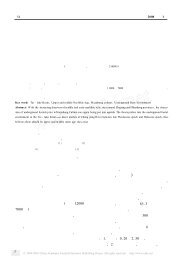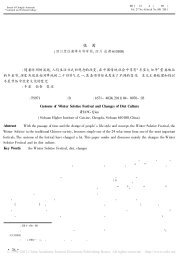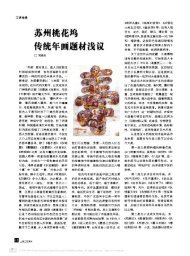清末民间社团的发展空间及其限度 - 吴文化网站
清末民间社团的发展空间及其限度 - 吴文化网站
清末民间社团的发展空间及其限度 - 吴文化网站
You also want an ePaper? Increase the reach of your titles
YUMPU automatically turns print PDFs into web optimized ePapers that Google loves.
JOURNAL OF EAST CHINA NORMAL UNIVERSITYPhilosophy and Social Sciences No. 5 2011———200241。“ ”。。 、“ ” “ ”。。、1 。“ ” “ ” 。。。 2 。。 “”。 。。。。 “ ”、 “ ”。 、。、。1901—1911 200 3 。“ ”1 。《》 1971 《》1975 《1901—1911》1983 《》 1991 《》 1995 。 《》 1994 《》 2001 。2 72 。 17 。 《》《》1995 3 。3 《1895—1911》 2007 161 。63
2011 5 。 19 “” 。、“ 、 ” 1 “ ” 、。20 “”、“”1906 “ ”“ ”2 。“”。《 · 》 “ ” “ ”。 “”“”“”、“”“”。“ 。 。 。” 3“ ” 。 “”“ ” 4 。“ ” 。“。” 5 20 “ 。 。” 6、“ ” 。“ ” “ ”“ ” 7 。“ ”、“ ”“ 。”“”“ 、 ”8 。“。。” 9 “”。“。。“ 。” 10 “” 瑏 瑡。“ ” 瑏 瑢。 “ ” 。“ ”。“ ” 、 、“ ” 。 。“ ”。 、。1 《 · 》《 》1989 3 。2 《》《》1979 44 。34 《 · 》《 》 31 33 。5 《》 1992 29 。69 《 》 “ · ”。7 《》、《》《 》1904 3 17 。8 《》《 》1904 4 24 《》《 》1904 4 25 。10 《》《 》1904 6 4 。 瑏 瑡 《》《 》1904 10 21 。 瑏 瑢 《》《 》1904 12 3 。64
。“ ” 1 。“ 、” 2 。“ ” 3 。 4 。“ ”、“ ”、“ ”“ ”、“ ” 。、。。“ ” 5 6 。“ ”。1905 1911 500 7 。1906 20 1909 370 8 。“”9 。 。 。 “ ”“ ”。 “ ”、“ ”、。 “” 10 “” 瑏 瑡 “” 瑏 瑢。 、“ ”。。 “ ” 。 “ ” “ ” 瑏 瑣。、“ ”。《 》“ ” “1 《》《 》1903 4 30 。2 瑏 瑣 《》《 》1904 10 21 。3 《》《 》1911 3 3 。4 《》《 》1904 6 4 。5 《》《 》1903 12 22 。6 《 》《 》7 1904 3 17 《》《》1984 94 。7 《》《 》1905 7 8 《》《 》1911 2 23 。8 《 》1993 1061 《》1909 。9 《》《 》1911 3 23 《》《 》1911 4 10 。10 《》《 》1906 12 30 。 瑏 瑡 《》《 》1903 5 16 。 瑏 瑢 《》《 》1904 8 27 。65
2011 5 。” 1 《 》“ 。、、、 、、 、 。 。” 2 “” 。、 、 、 、 、 、 、 、 、 、 、3 。。 、 。“” 4 。20 。 、 “、” 《 》《 》 、5 。“ ” 6 《 》 。《》《》、《 》、《》 。、 、。 、 。 、、 、。 。、 、 、7 。“ ” 8 。 “。” 9 、 、 、10 。 。。、 、 、 、 “” 瑏 瑡。 “” 瑏 瑢。“” 瑏 瑣。 、。1 《 》 “ · ”。29 《 》 《 · · 》 1989 96 94 。3 “ ”“ ”《》 1995 281—288 。 “ ”““ ”“。。4 《 》《 》 1957 458 。5 《》《》2 3 1934 12 847 。6 《》《 》1906 12 10 。7 《》《 》1904 8 27 。8 、《 》 “ · ”1918 《》《 》190911 13 。10 《 》 “ · ”、 “ · ”。 瑏 瑡 《》《 》1904 6 12 。 瑏 瑢 《》《 》1904 5 27 。 瑏 瑣 《》《 》1907 3 4 。66
、。“” “ ”“ ” 1 。“ ”“ 、 ” 2 。“ ”“ ” “ ”“ 、 ” 、“” 3 。“”“” 4 。 。 、 。20 “ ” 5 。“ ”6 。“”“ ”“”“”“ ”“” 、 、7 。 “”、“”、“ ”、“”8 。 “” 9 。“ ”“ ”“ ” 10 。1911 “ 、” 瑏 瑡。、 、。“” “” 瑏 瑢。 、“ ” “ ”“” 瑏 瑣。 、 。 、。 、 “” 瑏 瑤 “ ” 瑏 瑥。 “ ”“”。、 、 、“ 。” 瑏 瑦1 《》《 》1907 8 24 。2 《》《 》21 1902 7 5 。3 《》《 》1908 9 8 。4 《》《 》1908 7 14 。5 瑏 瑢 《·· 》 1989 109 110 。6 《》《 》1906 11 28 。7 《 》《 》1904 5 8 《》《 》1904 6 12 《》《 》1908 4 19 。8 《》《 》1906 11 27 《》《 》1906 12 18 《》《 》19073 25 。9 《》《 》1908 4 3 。10 《》《 》1910 5 11 。 瑏 瑡 《》《 》1911 2 14 。 瑏 瑣 《》《 》1907 4 27 《》 1981 174 。 瑏 瑤 《》《 》1909 11 25 。 瑏 瑥 《》《 》1909 6 30 。 瑏 瑦 《》《 》1907 5 30 。67
2011 5 。 1907 4 1 “” 2 、 、 、 、 、 、 、、3 。 、“ ”。20 “ ”。1903 4 。“ ” 5 。 、 、 。“ ” 6 。、、 。“” 7 。 、 “” 。。。 、、 。 1895 1925 30 “ 、 ”“ ”。“ 、 ” “ ” 、“” “” 8 。 “”“ ”。 《 》“ ”“ ” “。” 9 “ ”“ ”。 、 、 。 、。。 “ ” “ ”。1 《》《 》1907 4 1 。2 《 》 “ · ”。3 《》《 》1908 2 21 《》《 》1909 4 9 《》《 》1909 10 22 。4 《》《》88—89 。5 《》《 》1903 5 6 。6 《》《 》1904 9 23 。7 《·· 》110 。8 《》《 》 1999 4 52 。9 《 》 1989 50 。68
、 。 。 。20 “ ”。1904 6 21 “、 、 。 。” 1。。。。1904 “”《》。 。1906 、、、“”“” 2 。 、 、。 9 “ ”。1908 《 》“ ”“ 、 、”。 “ 、 、 、 、 。” 3 《》 “ 、 、 、 ” 4 。1909 《 》5 。 。 “ ”、。。1905 “ ”“ ” 1906 。“ ”6 。“ ” 7 “ ”“ ” 8 。“ ” “”、 “ ”“ ” 9 。1907 400 10 。 “ ”。 。 1 《》 1958 5191 。2 《·》 1993 247 。3 《》《》104—105 。4 《》“”《》59 。5 《》《 》1994 4 。6 《》 “”《》2001 88 。7 《》《 》1905 11 4 。8 《》《 》1907 2 5 。9 《》《 》1907 4 27 。10 《 》《 》1907 1 29 。69
2011 5 。“ ”。、 “ ” 1 。 。1904 《 》 “ ” “ ” 2 。1908《 》 “ ”。 “ ” 3 。《 》“ ”“ ” 、 、 、 、 、“ ” “”“ ”、“ ”、“ ”、“ ”、“ ” “”、“ ”、“”、“ ”、“ ”4 。。 。1908 8 11 。 “ 。” 5 。“”6 。。 “” 7 。。。“ ” 8 “”、 。“。 ”。 “” 9 “、 、 。” 10 。“ ”。“1 《》《 》1 2 1904 4 10 。2 《》 、 《· 》1991 482 。3 《》《》 105 。4 《》《 》1994 4 。5 、 《》 1983 468—469 。6 《》 1985 185 。7 《 》《》1 20 1908 12 6 。8 《》《 》9 1904 4 16 。9 《》《 》1904 6 2 。10 《》《 》1904 5 21 。70
” 1 “”“ ”、 。“ 。。 。” 2 。“ ”“ ” 3 “”“” 4 。“ ”、“ ” 。。 、。 20 、 、 、 、 、“ ” 。、。、 、 、。 “ 。 。” 5 “ ”、 “ ”、 、“ ”、 “ ” “ ” 6 。。“ ” 7 。 。1 《》《 》1904 6 2 。2 《 · 》《 》16 1904 7 22 。3 《》《》91 。4 《》 《》84—99 。 《》 “ ” 。5 《》《》1904 。6 《》《 》1904 11 9 。7 《》《 》1 1913 5 。71
views on East Asia by imperialists in history including Chinese Empire and Japanese Empire. Third the visionof this study plays an important role in helping us deeply understand and reflect political-cultural historyand social-cultural history in East Asia in modern times. Finallythe study of Confucianism can provide animportant chance for Confucianism to go to the world and participate in dialogues among civilizationsand providesome helpful thoughts in dealing with globalization problems.KeywordsKoyasu NobukuniHuang JunjieEast AsiaConfucianismglobalizationOn Zhu Xi’s Theory of Removing Old Habitsby Lu Qi-weiAbstractThe purpose of Zhu Xi's theory of cultivation lies inby removing influences of bad habitsactualizingthe original nature in order to ascend the level of personhood to the utmost. Zhu Xi conceives that anold habit retains two dimensions of dispositionnamelya disposition that flows from the“internal factor”andthe other that flows from the “external factor”. He also makes an exploration of how to get rid of those oldhabits. Zhu Xi states that school education and children's education have a positive influence on the personaldevelopment. In accordance with views of “behavior theory”and “local philosophy”this paper makes a reinterpretationof Zhu Xi’s idea of removing old habits so as to highlight his theory’s positive influence upon aperson’s cultivation of virtues.KeywordsZhu Xielementary educationhabitbehavior theoryThe Development Space of Mass Organizations and Its Limitation in theLate Qing Dynasty———A Focus on Shanghaiby Fang PingAbstractIn the last decade of the Qing Dynasty there emerged various new-style social organizations inShanghai with a general elevation of social members’“sociable”consciousness. These mass organizations hadtheir different missionsbut they tended to “maintain public good”and organized varied activities to developtheir own ideas and influences. Consequentlythey expanded the urban public life and effected reorganizationsof local society. Owing to some subjective and objective factors these non-government social organizationswere limited in their development space.Keywordsmass organizationsocial evolutionpublic welfare limitationThe SchoolStudent and Modern Concept of State during the Period beforeand after the Revolution of 1911by Qu JunAbstractThe modern concept of state is one of the most important concepts in the process of China to itsmodernization. Before and after the revolution of 1911a new school system with a combination of newspapersand public opinions provided popularity of such a concept of with a strong support. Students in this processproduced their admirations of some famous scholars in the late Qing Dynastyand also developed a form of "foreign and Chinese debate" so as to affect their ideas in comparison. Thusstudents' life worldknowledgeworld and even feeling world had significant changes during the period before and after the revolution of 1911.Keywordsperiod before and after the revolution of 1911schoolstudentmodern concept of state153
















